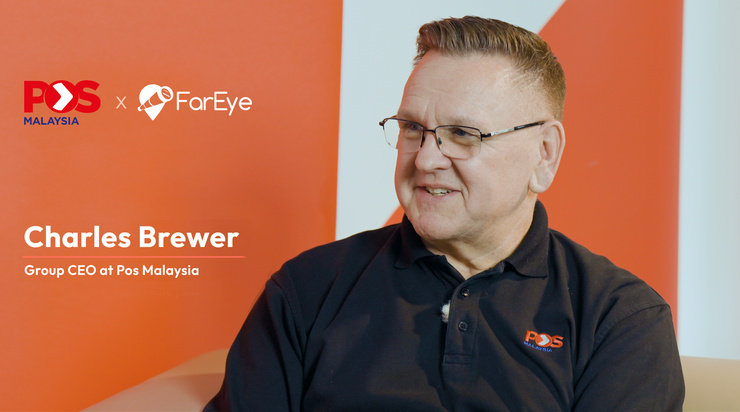- Logistics
Freight Management: Strategies for Efficient Shipping Operations
Table of Contents
- What is Freight Management?
- Why is Freight Management Important for Your Business?
- What Are The Core Functions of Freight Management?
- What Are Some Strategies to Optimize Your Freight Management?
- Choose FarEye’s Transportation Management System for Freight Management
- Conclusion
- Frequently Asked Questions

Imagine this: you’ve got a shipment scheduled to leave your warehouse by afternoon. Half of it is headed in a full truckload, and the rest is split across smaller Less than Truck-Load deliveries going to different cities. One of your regular carriers just called to tell you that they are stuck in traffic and are running late. And to top it off, diesel prices have gone up once again.
Freight logistics isn’t just about moving goods from point A to point B anymore. It’s about how efficiently, predictably, and cost-effectively you can make that movement happen over and over again. That is what freight management is really about.
Freight management is the system that keeps everything from slipping on a banana peel. It’s like your all-rounder PA who helps you stay on top of shipments, juggle carrier coordination, stick to the delivery windows, and avoid getting blinded by extra costs or last-minute customer demands.
In this blog, we’re going to walk through what freight management really looks like in practice. You’ll see why it plays a bigger role than most people think and pick up some simple ways to make your freight operations less reactive and more in control.
Whether you’ve been dealing with freight for years or just started noticing how chaotic it’s getting, this is a solid place to step back, regroup, and figure out what to fix first.
What is Freight Management?
Freight management is the end-to-end process of planning, executing, and optimizing the movement of goods to ensure timely, cost-effective delivery. It’s what helps you ship efficiently, keep costs in check, and make sure deliveries happen on time.
Let’s say you need to ship products to five different cities this week. You have the liberty to choose the type of shipment that best works for each shipment. This includes:
- Full Truckload (FTL): This is when a single shipment fills up an entire truck. Let’s say one shipment is large enough to fill an entire truck, in this case, it goes straight to the destination.
- Less-than-Truckload (LTL): This is when multiple smaller shipments share space in one truck. If two shipments are too small for their own trucks, then they can be combined with other companies’ cargo in a shared truck.
- Multimodal: This is when a shipment uses more than one mode of transport (rail, road, sea, and air) to reach its destination. If a shipment is going to a remote area where using just road isn’t ideal, then the shipment’s transport into road + rail, sea, or air.
Freight management covers all of these scenarios without losing a sweat. It helps you select the right transport mode, book the carrier who's the best at that time, plan the best routes, track the shipment in real time, and make any adjustments if something take a bad turn.
It’s about letting you be the one in control, from the moment the goods leave from your facility to when they arrive at their destination (and sometimes back to the facility).
Why is Freight Management Important for Your Business?
Controls Cost
Shipping costs have a way of getting out of hand. One delay here, a fuel hike there, a poorly planned route, and suddenly, your budget’s taking hits you didn’t see coming. Freight management steps in to stop the bleeding.
It cuts the waste, tightens the plan, and helps you spend where it actually counts. This leads to fewer empty miles, better consolidation, and clearer carrier contracts.Improves Delivery Performance
Missed SLAs and late deliveries wear your relationships down with both your customers and carriers. With a solid freight management in place, goods get to their destinations, avoiding surprises as much as you can.
When you keep your delivery performance at a stable rate, it slowly builds reliability and trust over time and encourages customers to come back.Provides End-to-end Visibility
Freight management also includes the ability to track shipments in real-time. This means you know where your shipments are, which shipments are getting delayed, why they are delayed. This lets you take prompt action that resolves issues quicker and minimizes the damage the delay causes.
Enables Scalability
As your shipment volumes grow, freight gets more complex. A solid freight management system gives you the structure to handle more shipment, explore new markets, or switch up your delivery models without breaking your flow.
What Are The Core Functions of Freight Management?
The core functions of freight management include planning shipments, execution, and tracking the activities. Let’s take a deeper look at what these functions hold.
Planning Shipments
Good freight management always starts with planning. If you get this part right, the rest becomes much easier to manage. Planning includes:
- Choosing the transport mode: Does it need to go by road, rail, or a mix of both? Are you sending a full truckload or a few boxes? The right choice depends on delivery timelines, shipment size, and cost.
- Selecting carriers: Some carriers are reliable for long hauls, others are better at last-mile delivery. Freight managers usually maintain a list of preferred carriers and choose based on price, performance, and availability.
- Route design: This is more than just picking the shortest path. It’s about balancing cost, speed, and risk. For example, avoiding routes known for congestion, even if they are technically shorter.
- Shipment consolidation: If you have multiple small orders going in the same direction, combining them into a single load can significantly reduce freight costs.
Execution
Once planning is done, execution puts everything into motion. This phase is all coordination and timing.
- Carrier tendering: This is the process of offering a shipment to a carrier. This process can be automated in a TMS like FarEye by aligning the shipment characteristics with the optimal route and carrier.
- Load consolidation: If you are sending multiple orders in the same load, this step ensures that they are grouped, packed, and labeled correctly, so nothing goes missing during delivery.
- Dispatch activities: This includes preparing documents, sharing instructions with the driver or carrier, and getting the vehicle out the gate on time. Communication is key here, especially if you are working with external partners.
Tracking the Activities
Shipping doesn’t end when the truck leaves your warehouse. The next big function is tracking the shipments that are dispatched:
- Real-time shipment monitoring: Whether it’s through GPS, carrier portals, or a TMS, freight managers need to keep tabs on where shipments are at all times.
- Status updates and notifications: These help you and your customers know what’s going on. Is the shipment in transit? Is it getting delayed? Or has it been returned due to customer unavailability?
- Exception handling: This is where you respond to issues like delays, reroutes, damaged goods, or failed deliveries. The right system doesn’t stay quiet when something’s off. It flags issues early, giving you enough room to act, suggest different carriers, shift the ETA, loop in the customer, before it turns bad.
What Are Some Strategies to Optimize Your Freight Management?
Freight gets messy fast. One delay turns into five. Costs climb. Details slip. But no, it need not be that way forever. All it takes is a just a few changes and voila, things back under control. This means you scramble less, get surprised less, and get better results across the board. Here’s what you can do:
Adopt a Modern Last-mile Delivery Platform
A modern last mile delivery platform (like FarEye) takes care of the repetitive work and brings everything into one place, from carrier selection, to route planning, to dispatch.
Say you’re trying to find a truck. Instead of calling five carriers and hoping one picks up, a last-mile platform can just handle it. You set the rules, maybe it’s cost, maybe it’s delivery speed, and it shows you the right one without the back and forth.
It also figures out the best route while the day’s unfolding. If there’s traffic, it adjusts. If a window’s closing, it reroutes. Your team spends less time chasing details and more time actually moving things forward.
Use Real-time Data and Analytics
Freight is full of moving parts, and without live data, it is easy to fall into firefighting mode. Real-time visibility gives you patterns of failures enroute a delivery which you can analyze. For example, if a certain region is facing regular delays due to traffic at a particular time, then you can change your delivery windows.
In the long-term you can also analyze cost related aspects of freight. You can answer questions like, am I overspending on fuel? Is this route optimized well? Is my load consolidation good?
The more questions you can answer, well, the more optimized your operations will become.
Consolidate Shipments If Possible
We touched upon this in the previous point. Consolidating shipments is one of the most straightforward ways to cut costs and everyone knows this. But the real opportunity is in doing it more intelligently and more often. That means not waiting until the last minute to plan loads.
If your planning window is too short, you are forced to ship whatever is ready, even if the truck is half empty. A more effective approach is to use forecasting and order visibility to group shipments ahead of time. Some shippers also layer in customer flexibility by offering incentives for slightly delayed deliveries, just to make consolidation work.
Strengthen Carrier Partnership
It is easy to treat carriers as just vendors, but the truth is, they can make or break your delivery performance. When you invest in strong, two-way relationships, you are more likely to get better service, faster responses, and more flexibility when things get tight.
That means, being transparent with your shipping needs, giving carriers enough lead time, and reviewing reliability performance regularly. It also means giving good carriers more business and rewarding reliability with better contracts.
Over time, this creates a level of trust that makes your freight operations smoother, especially during high-demand periods when everyone is scrambling for capacity.
Choose FarEye’s Transportation Management System for Freight Management
FarEye is built to give businesses smart freight tools, leading to smoother operations, better control, and stronger results. Here are the capabilities that make it stand out:
- Yard Management: FarEye provides real-time logistics visibility that includes yard and in-plant tracking. This helps you monitor incoming shipments, oversee material flows, and manage yard operations efficiently.
- Multi-modal Visibility: FarEye enables unified real-time tracking across road, rail, air, and sea modes, all in one dashboard so nothing slips through the cracks.
- Extensive Carrier Network: The Transportation Management System integrates with hundreds of carriers, making it easy to tender loads, compare performance, and manage contracts.
- Low-code, Cloud-based System: FarEye’s low-code interface supports drag-and-drop workflows and rapid configuration. Teams can set up new rules, carriers, or integration points without waiting on IT.
- Dynamic Delivery Routing: Powered by AI and machine learning, the system optimizes routes real time. It takes into account traffic, weather, delivery windows, and vehicle capacity, to reduce miles and improve ETAs.
- Experimentation with New Delivery Models: Whether you are piloting micro-fulfillment, hub-and-spoke operations, or EV routing, FarEye’s modular platform allows you to test and scale different delivery models without overhauling your system.
Experience efficient and effective freight management with FarEye. Let’s Talk!
Conclusion
Freight management isn’t just a box-ticking job anymore. You’re not here to move goods and hope for the best. You’re here to move them smarter, faster, and without setting fire to your budget when something unexpected hits, which, let’s be honest, happens more often than not.
Customer demands keep growing. Capacity keeps shifting. Prices refuse to sit still. You can’t afford to “just ship it” and deal with the fallout later. If you don’t have a system that helps you stay alert and flexible, you’re already behind.
The businesses that take freight seriously know it. They’re CCTV-ing every shipment, fixing every bad route, keeping tabs on carriers, and spotting issues before the heat spreads. They don’t panic when a delay hits, they pivot, adjust, and keep things moving.
That’s the edge a platform like FarEye gives you. You’re not digging through spreadsheets or waiting for someone to call you for an update. You’re seeing shipments live, tweaking routes in real time, getting visibility at the dock, and knowing when a carrier's falling short before customers start calling.
If your shipping ops still feel like you’re patching things as they break, freight management is where to focus. And if you want to go from reactive to actually running the show, FarEye gives you the tools to do exactly that.
Frequently Asked Questions
What is the role of freight management in logistics?
Freight management keeps shipping from falling apart. You’re planning routes, booking carriers, tracking every movement, and jumping in when things go sideways. It’s the part that holds the chaos together so you’re not scrambling every time an order goes out during a busy week.
How can I improve freight management efficiency?
First, figure out what’s slowing you down. Too many spreadsheets? Delayed updates? Drivers calling instead of your system pinging you? Start there. Then get tools in place that reduce the mess, something like a TMS that doesn’t need babysitting. The goal isn’t just moving faster. It’s fewer surprises, less stress, and better control when things get loud.
How does real-time tracking help freight operations?
It shows you what’s happening while it’s happening. You don’t have to guess where the truck is or wait for someone to call. If a shipment’s running late, you see it early and do something about it. It keeps your team sharp and your customers in the loop without chasing updates at the last minute.

Komal Puri is a seasoned professional in the logistics and supply chain industry. As the AVP of Marketing and a subject matter expert at FarEye, she has been instrumental in shaping the industry narrative for the past decade. Her expertise and insights have earned her numerous awards and recognition. Komal’s writings reflect her deep understanding of the industry, offering valuable insights and thought leadership.
Let's Talk to Our Experts and Optimize Your Deliveries Today!
An expert from our team will reach out within 24 hours
Related resources


